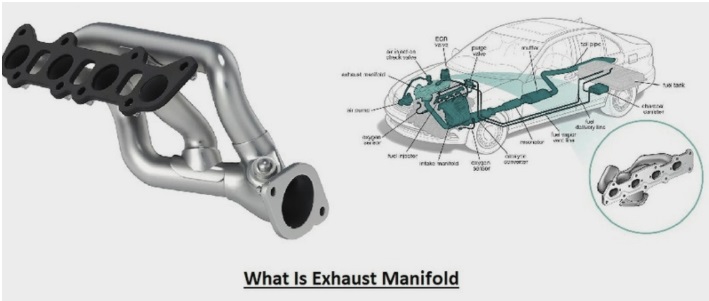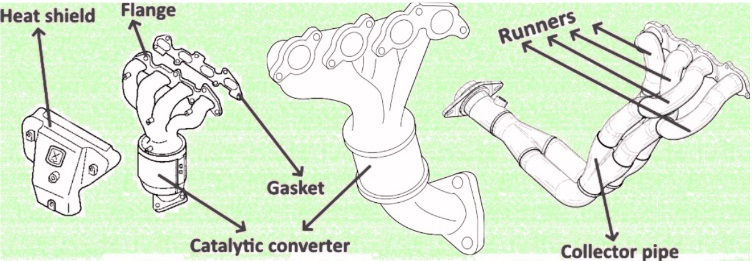The engine block configures the exhaust manifold, which is the first part of the vehicle’s exhaust system. Its function is to gather exhaust gases from the cylinders and send them towards the catalytic converter of the car. A V-type engine comes with a separate manifold in each cylinder bank. Gas releases due to a leak in the exhaust manifold can cause bad effects for car users and also give wrong results for oxygen sensors and on checking the engine light.
Here we will cover details for the exhaust manifold’s working features and other details.
What Is an Exhaust Manifold?
- In vehicle exhaust manifold gathers exhaust gases released from different cylinders in a single pipe. Exhaust manifolds are units that are made with stainless steel or cast iron, get engine exhaust gas from different cylinders, and provide it to the exhaust pipe.
- 2, 3, and 4-cylinder engines come with one exhaust manifold since there is one bank of cylinders for extracting exhaust gases.
- The engine that comes with Vee configuration comes with 2 manifolds, one used for one bank.
- Exhaust manifold main issues are holes and cracks, which are easy to find since the exhaust produces more noise.
- The manifold gasket that exists between the engine and the manifold can also be damaged, producing similar noise. Solve these issues as soon as possible to avoid causing serious issues for the engine’s performance.
- The exhaust manifold becomes heated, so it mostly comes with a heat shield for the protection of other components and lines under the bonnet.
- Manifolds also have insulation from ceramic coating, that is high cost and that is a high-cost option but it reduces the working life of the manifold. So bare metal is used for this purpose.
Intake and Exhaust Manifold
- The intake manifold used for fuel air mixture distribution in inner cylinders for the combustion process, and the exhaust manifold are fed by the product of combustion gases released.
- Working as a channel and path for exhaust gases from the combustion chamber into the exhaust tube, the exhaust manifold provides high fuel efficiency and also increases the car’s working performance.
Exhaust Manifold Working
The main function of the exhaust manifold is to gather gases from the internal combustion engine and send them to the exhaust pipes. This process takes four steps , explained here.
Exhaust Gas
- The exhaust manifold has a direct connection with the engine cylinder in that place combustion occurs as a result of the fuel and air mixture when the engine operates. The exhaust valve in the cylinder opens in this process, making expulsion of combustion and high-pressure and temperature exhaust gases.
Merging & Channeling
- This process is used for exhaust manifold pipes that make the connection of the car’s internal combustion engine with the exhaust based on the cylinders connected in the car.
- Manifold makes merging of each pipe in a single outlet for proper combination before channeling in another tube. Combining merging and channeling processes provides an equal flow of exhaust fumes.
Backpressure Control
- The exhaust manifold also optimizes the backpressure. Gas-releasing cylinders also face resistance or backpressure. The exhaust manifold reduces pressure and provides an easy path for the cylinder.
- This process helps to provide a constant flow of gases from the internal combustion chamber for power production and also increases car efficiency.
Tuning
- Tuning increases the efficiency of your car. These features of the exhaust manifold do not work for all types of vehicles. It is for a manifold that comes with a tuned length structure.
Bad Exhaust Manifold Signs
Noises
- If the engine produces more sound, that is a sign the exhaust manifold is causing a leak. If there is a leak, unfiltered gas releases from the exhaust system in the engine, generating a louder sound than normal.
Low Fuel Economy
- The leak in the exhaust manifold also affects fuel efficiency. If you are visiting more gas stations than normal, check the exhaust manifold.
Smells
- If there is a leak in the exhaust manifold, gases are released externally into the air before transforming into low-toxic gases. As a result, there is a smell coming from the hood.
Low Acceleration Power
- The leak also resulted in low engine power. If the car is not accelerating as it normally does, that is a sign of a bad exhaust manifold.
Engine Light Turns On
- If there is a leak in the exhaust system causes the sensors of the car to detect the issue, and as a result engine light turns on. If the car has these signs, check that the manifold is leaking.
Manufacturing Process for Exhaust Manifold Components
Die Casting
- Die casting is a process that is employed for the production of exhaust manifolds, mostly for bulk production. The casting process uses metallic heating, like cast iron or aluminum, to melt the metal before pouring it into a pre-made mold. For the mold cavity, liquid metal cools and becomes solidified into different shapes through high pressure.
- When the exhaust manifold structure is made with a different process of CNC machining, it is applied for making the final assembly. This process is good for the production of automotive manifolds since it has features to make complex designs with accuracy.
CNC Machining
- CNC machining is a commonly used method for different processes in automobiles, such as cylinder head machining. For exhaust manifold manufacturing, it is a common process that is used after casting.
- Die casting is more common but not commonly used like CNC machining. So manufacturers use CNC machining features for good shape and finishing a casted manifold. That comes with shaping, drilling, and milling the exhaust manifold to provide the required tolerance and features.
3D Printing
- 3D printing is a good process for different manufacturing processes, such as automotive parts creation, but has limited uses for automotive metallic manufacturing. Since it has a high cost, mostly materials used for 3D printing, such as PLA and ABS.
- 3D printing is beneficial for rapid prototyping of components in custom parts and is used for making complex designs in casting molds.
Uses of Car Manifolds
Emission Control:
- The main function is to direct exhaust fumes of internal cylinders to the vehicle exhaust system. That reduces bad emissions in the environment.
Engine Performance:
- It controls the outflow of unburnt gases to provide high power and torque, such as fuel efficiency of the vehicle. That provides high performance.
Heat Control:
- Racing cars and high-performance cars needed exhaust manifolds with good heat dissipation features. Custom manifolds provide good heat dissipation, which is good for the vehicle engine’s long-lasting working.
Read also: What is Broaching Process? Features, Working, & Types
FAQs
What is the outcome of a bad exhaust manifold?
- It is not common, but damage to the exhaust manifold causes more damage to different components like the cylinder head and catalytic converter. Noxious exhaust gases move to the cabin. If exhaust manifolds ared, they will be replaced, not repaired.
Is it good to drive with a bad exhaust manifold?
- Exhaust manifolds’ gaskets work longer, but there is a chance of damage. Do not drive the car until the faulty exhaust manifold gasket.
Do custom car manifolds affect car performance?
- Yes, custom car manifolds increase car performance. Optimize lengths and collector design to provide a car to get high RPM and also increase torque and power output for driving.
Where is the manifold in a car?
- It is normally connected below the car hood. We can find it connected to the engine cylinder with a series of pipes that make the connection of exhaust gases.
How to check if a car manifold is faulty?
- The main signs of a faulty car manifold are engine misfiring, noise production, bad fuel economy, and low power production. If we check pipes and tubes, there is a crack or leak seen on the manifold.
How much does exhaust manifold replacement cost?
- The average cost for replacing the exhaust manifold is $1,100 to $1,300, which includes the cost of parts and labor. Some exhaust manifolds can cost about $3,500.
What are the outcomes if you don’t fix the exhaust manifold?
- The exhaust valve damage leak occurs due to a damaged oxygen sensor or issues with the catalytic converter. It also increases fuel use and increases cost.
What are the signs of a broken manifold?
- Bad Performance.
- Poor Fuel Economy.
- Burning Engine Odors.
- Start-Up Sounds.
- Engine Warning.

